

Parsnip is a delicious heirloom vegetable with edible roots.
Important Parsnip facts
Name – Pastinaca sativa
Family – Apiaceae (parsley family)
Type – vegetable, biennial
Height – 20 to 28 inches (50 to 70 cm)
Exposure – full sun
Soil – rich and cool
Sowing: early to late spring – Harvest: fall
The ultimate fall and winter vegetable, here are the tips on how to grow it.
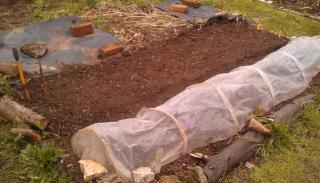 Parsnip is sown from February to June but must be started under shelter if freezing is expected early on.
Parsnip is sown from February to June but must be started under shelter if freezing is expected early on.
Once any risk of freezing has faded away, it is possible to sow directly in the ground. Whether in a sheltered place or outdoors in summer, sprouting lead time for parsnip is more or less 12 to 15 days.
Avoid planting parsnip in the same spot for the following 4 years, so that the soil may recover.
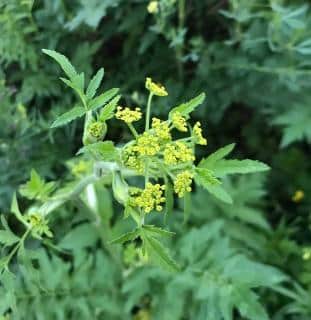 Parsnip requires extremely little care. The only relevant care is the same as for all other plants, like regular weeding.
Parsnip requires extremely little care. The only relevant care is the same as for all other plants, like regular weeding.
As for watering, it is useful to water during summer heat waves or prolonged dry spells, without wetting the leaves.
Lastly, to increase the harvest in quality and quantity, provide special vegetable patch fertilizer in spring.
Parsnip harvest takes place more or less 4 to 5 months after sowing. It usually takes place between August and October-November, or March.
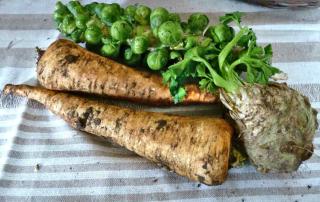 Here, parsnip harvest gathered together with Brussels sprouts and turnip root chervil.
Here, parsnip harvest gathered together with Brussels sprouts and turnip root chervil.
Average parsnip productivity is more or less 6 to 8 roots to a square yard (1 m²).
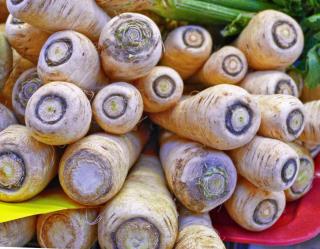 Being a root vegetable, parsnip naturally keeps for a long time, both still in the ground or harvested.
Being a root vegetable, parsnip naturally keeps for a long time, both still in the ground or harvested.
It is also doable to let the parsnip sit in the ground and only collect it when you need it.
Parsnip particularly LOVES growing nearby cabbage, radish, beans, onions and broad beans.
Parsnip DREADS growing too close to lettuce.
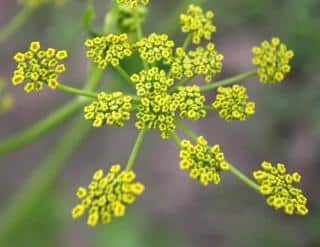 This vegetable is a great source of benefits for the body, most of which have long been known.
This vegetable is a great source of benefits for the body, most of which have long been known.
Indeed, parsnip has high vitamin B9 and carbohydrate levels and has stimulating properties for health, especially as regards the immune and reproductive system.
Note also that is has a high fiber and mineral content and contains many antioxidants which help fight colon cancer.
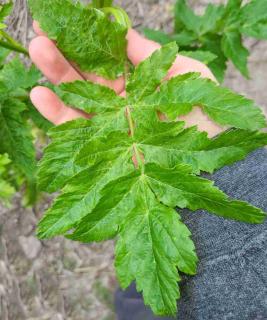 Bulbous parsnip, as its name shows, is roundish in shape.
Bulbous parsnip, as its name shows, is roundish in shape.Also, parsnip is both sweet as carrot sometimes is, and fruity like celery. So it appreciated raw and grated for instance, or mashed to a puree or added to stewed meat.
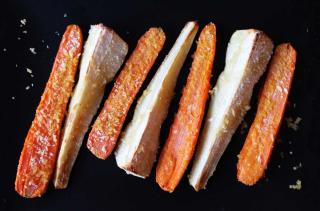 Cooked in soups and stews is how parsnip is often eaten. It occasionally appears in purees together, with other vegetables such as potatoes or carrots. Simple baking with a dash of salt, here with carrot, is also a tasty side.
Cooked in soups and stews is how parsnip is often eaten. It occasionally appears in purees together, with other vegetables such as potatoes or carrots. Simple baking with a dash of salt, here with carrot, is also a tasty side.
Some families like to add it to beef stew or tajine, partly because it doesn’t fall apart as it cooks.
It can be paired with meat and fish, for instance as a parsnip puree, and can be added as an herb simply to flavor broth and soup.
Just like leek, parsnip is a diuretic and eases digestion. It will also provide you with a lot of vitamin B9!